Rare Early Post-WWII Model Steiff Molly Puppy Dog Gorgeous Coloring 2 IDs Plus US-Zone Flag
$329.00 Original price was: $329.00.$99.99Current price is: $99.99.
- Quality You Can Count On
- 100% High-Quality Guarantee
- 7 days free returns
- We take quality seriously.

Bow wow WOW! Is this puppy fantastic, or what!!?? Molly, in any of her sizes, has been a favorite of Steiff collectors since she was introduced in 1925. One of the interesting things about her is that she seems to be a mutt. She is not identified by breed, but merely called a “Junghund,” German for “young dog,” or “puppy.” She seems to have some terrier-type features, but what do I know; I’m a cat person! 😉 If this paragraph looks familiar to you, you have seen it twice before in my descriptions of Molly’s two smaller sisters.
Molly is in absolute accord with her catalogue measurement of 17 centimeters to the top of her head, or just under 7 inches. That size is indicated by the “17” in her article number, 3317, which you can see clearly printed on her flag. designates her catalogued size.
That number belonged to Molly’s earliest post-war series, which spanned the years from 1949 to 1958. I can narrow down her production time from both directions. Molly’s flag is anchored by a raised script button, so it is highly likely that she was made in 1951 or later. Her US-Zone flag (a shredded but still substantial remnant) puts her latest year of production at 1954. I know Pfeiffer says 1953, but I can think of later instances of animals with that flag.
Actually, what I just said is not absolutely accurate. 😉 Although the US-Zone flag on an animal puts its latest production at 1954, Molly’s ear flag, with its early font and wording, probably makes her latest production 1952, the very next year after that determined by her button. With the outside date limitations being defined by only two years, Molly is a very rare puppy indeed!
Although you can read this in her 14-cm sister’s description, I will tell you here too. The early words (whose use on flags started decades earlier) are “Original geschützt.” The second word means “protected,” and such a marking is equivalent to the “®” or the “©” we see all the time for items that are protected by trademark or copyright. Sometimes (and I don’t know if there is an underlying “rule” for when), you see those words abbreviated as “Orig. gesch.” In fact, another early pup in my shop has just such a flag, the gorgeous seated brown and white Cockie. If you look at Cockie (by all means do!), you will notice that her chest tag is printed in red ink. If Molly had retained her chest tag, it, too, would have her name in red.
With all this talk of flags, there is something you should know. I believe it started as a factory blunder, and Molly’s subsequent handling made things worse.
When I looked inside her sewed-down left ear to see Molly’s button, her button and flag attachment fell out into my hand. That, itself, might have been an easily solvable problem (at least by my husband, whose familiarity with tools and their skillful handling)—just to re-insert the button/flag combination. But part of Steiff’s error, in addition to failing to make sure that the attachment of the button and flag to her ear was secure, was never having put the button WHOLLY over the flag, such that its prongs had something to grab onto. Rather than that, the button was attached loosely at the VERY EDGE of the flag, and it played almost no role in making a joint button/flag union. The button and flag fell into my hand as essentially two separate items, attached by a few thin threads, which was what remained of the edge of the flag.
I was afraid to even touch the two things, since I feared severing the button/flag juncture with one wrong move, and there would be nothing left of the disintegrated end of the flag into which to insert the button. I COULD have (asked my husband to) reinsert the button alone, but the flag is such an important extra piece of ID, and I did not want to forfeit it!
The best way to describe what I did was to “re-weave” the end of the flag, making a criss-cross of stitches around the button catching tiny threads from the original flag in the process. It was certainly not a pretty sight, but I managed to create enough substance to hold the button and flag together, and, more important, to reinsert them as a unit deep down into Molly’s ear. I even managed to take a picture, in which you can see the whole button. What you don’t see is my re-weaving of the end of the flag, even deeper down into Molly’s ear. Given what I (and Molly!) had just gone through, I was a bit timid about manipulating her ear enough to produce a good picture, but my (amazing!) husband assured me, the connection, of one to the other and of both to her ear, was fine. PHEW!
As I say, although Steiff’s initial blunder only manifested itself after Molly left the factory, I consider the button-flag fiasco to be, for lack of a better word, a “birth defect,” and although Molly has a few minor issues as the result of owner handling, they are not enough for me to characterize her condition as anything less than very good-plus. And as you know if you have ever read another of my descriptions, I am rating her condition absolutely, not “for her age.”
Molly has really only one issue, which is wear. Most of that wear is along her seams, and you can brush her long hair to camouflage it somewhat. She does have a small amount of overall wear, but the most noticeable place is around her muzzle. That area is harder to camouflage, but I believe it makes no real impact on her gorgeous presentation. And when you are looking at her muzzle, notice her lustrous floss nose and the upside-down “v” representing her mouth. And notice, too, the really nice dollops of rose-colored airbrushing above her nose and below her mouth.
Speaking of coloring, Molly’s is fantastic! Her white could not have been any closer to the color of snow 70-plus years ago when she left Giengen. Likewise, her auburn tipping is gorgeous and dark.
Molly’s last positive thing to note is the almost pristine condition of her bow. I am talking about both its coloring, which does not seem to be faded, and its lack of fraying. You might have guessed as much because of the rest of its condition, but I will note that the bow is still attached to Molly’s back.
Finally, and almost always the last part of my description—because it has no bearing on Molly’s display appeal—I will tell you that Molly squeaked her last sometime before she arrived at my door. You can feel her squeaker depress when you push in on her belly, but she no longer “barks.” As I always point out, since it is likely you will display Molly in your vitrine or some other kind of cabinet, when you or anyone else passes by the case and admires her—which they WILL—they would not know whether she barked or not.
I can’t think of anything else to tell you, but please write if you have a question. Molly is a rare puppy, indeed, and she belongs in any serious Steiff collection, whether that is yours or belongs to the person who will be receiving her as a gift (lucky him or her!). And don’t forget about Molly’s two sisters; it would be great to keep the family together!
WHATEVER YOU DECIDE TO DO ABOUT MOLLY OR ANY OF MY OTHER STEIFF ITEMS, PLEASE BE SURE TO SEE THE ARTICLE I HAVE WRITTEN ABOUT STEIFF ID FRAUD—INCLUDING COUNTERFEIT CHEST TAGS—(AND OTHER IMPORTANT INFORMATION FOR COLLECTORS). YOU WILL FIND THE LINK ON THE BOTTOM RIGHT OF MY SHOP HOME PAGE UNDER “FAVORITE LINKS.” IF YOU HAVE NOT LOOKED AT IT RECENTLY, I UPDATED AND EXPANDED IT IN MARCH, 2023.
| ITEM ID | rl-2953 |
|---|---|
| COLOR | Brown, White |
| ITEM TYPE | Vintage |
| FINE PLUSH AGE | Post 1950 |
Be the first to review “Rare Early Post-WWII Model Steiff Molly Puppy Dog Gorgeous Coloring 2 IDs Plus US-Zone Flag” Cancel reply
Related products
Cats
Rare Sweet 17 CM Steiff Black Cat US-Zone Flag For Halloween And All Year Round 1950-1955 Only!















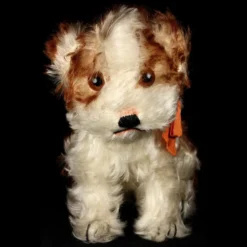













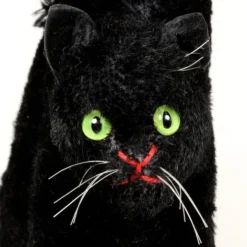
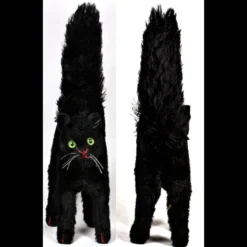
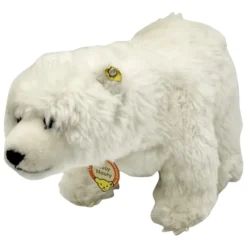
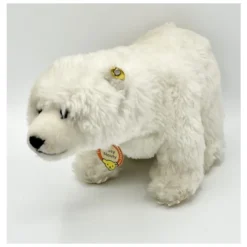
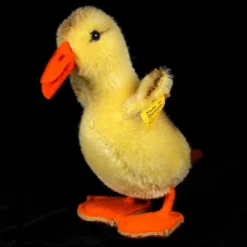
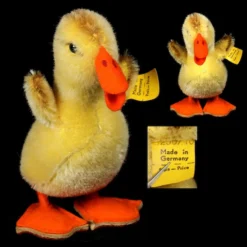

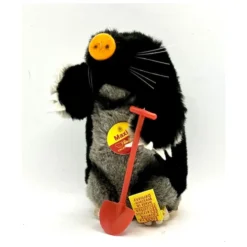
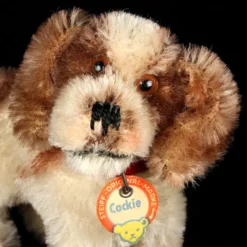
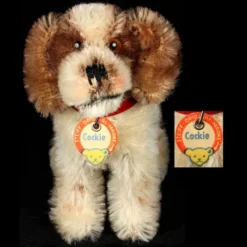

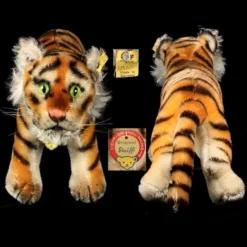

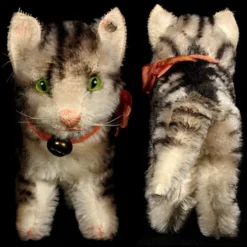
Reviews
There are no reviews yet.